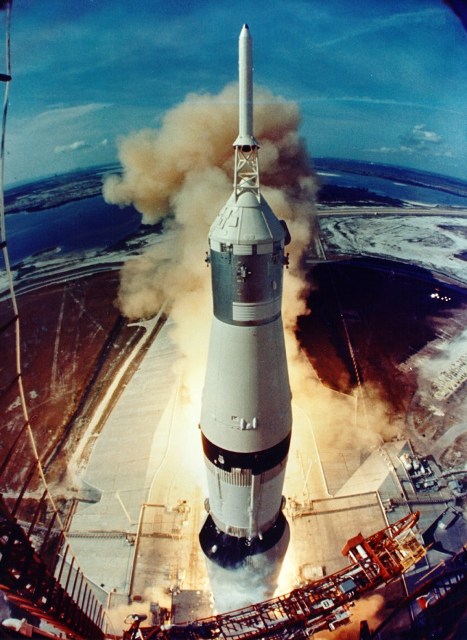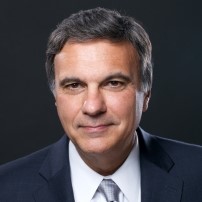The Future was Fifty Years Ago – Remembering Apollo 11
By Albert J. Pucciarelli
In July, 1968, just weeks after I graduated from high school, my cousin Ray Cerrato, an aerospace engineer, asked if I would like to visit him at his job. And what a job it was! He was working for NASA on manned space flight at the Kennedy Space Center (“KSC”). That humid, Florida day at KSC will forever be a vivid memory. We entered the gigantic Vehicle Assembly Building (the “VAB”) where the size and complexity of all I beheld was astonishing, most spectacularly the Saturn Vs that were being assembled for the first lunar orbital flights. (Apollo 8 orbited the Moon on Christmas Eve later that same year.) I saw the mammoth crawler that would carry the fully-assembled Saturn Vs and their launch platforms and towers out to Launch Pads 39A and 39B. I visited an office where even then re-usable vehicles to follow the Saturn program were seen as concepts that later became the Shuttle program. A year later, on July 20, 1969, Neil Armstrong and Buzz Aldrin walked on the Moon while Michael Collins orbited the Moon in the Apollo Command Module awaiting their return in the upper stage of the Lunar Excursion Module (the “LEM”). I felt a special connection because I had seen the tools of this effort up close the summer before. The Apollo program with its six successful Moon landings (Apollo 13 being the only mission that had to abort its intended Moon landing) has been called “man’s greatest adventure,” and I believe it was so.
Just four months ago, I again visited KSC as part of the Lawyer-Pilots Bar Association conference at Cocoa Beach, Florida. I landed my own airplane on the 15,000-foot long, 200-foot wide Shuttle runway, and the next evening I attended a reception under the beautifully displayed Saturn V that was built for subsequent Moon landings that were “scrubbed.” The American will to continue beyond those six lunar landings seemed quickly to evaporate in the early 1970s. As in 1968 when I first saw a Saturn V up close, I was equally in awe at its size and complexity. I thought about the famous clips of those Saturn Vs initially lifting slowly from the pad and minutes later speeding through the ever-thinning and darkening atmosphere at multiples of the speed of a bullet – 225,000 feet high and 6,000 mph at first-stage separation. Amazing in 1969 and no less amazing in 2019.
The last of six successful Moon landings was by the Apollo 17 crew on December 11, 1972. And so by the end of 1972, the spectacular national effort initiated by President Kennedy had come to an end. In a speech before Congress on May 25, 1961, President Kennedy had implored the Congress and the American people to meet the challenge of space exploration and to land a man on the Moon and return him safely to earth before the decade was over. That was accomplished by Apollo 11.
It was almost ten years after the last Apollo mission that the first Shuttle (Columbia) was launched. Perhaps it is meaningful that the Shuttle used the same launch facilities as the Saturn V. But for the Shuttle vehicles, the 400-foot high launch towers were substantially reduced in height because the Shuttle in launch configuration is only 158 feet tall compared to the Saturn V’s 363 feet. While the Shuttle was originally intended to be a quickly re-usable vehicle with multiple launches every month, the changed priorities of the American public and the unforeseen technical problems of the Shuttle, coupled with its greater-than-expected cost per launch, greatly impeded the Shuttle program. Rather than a stepping stone to more lunar missions and a possible mission to Mars, it became exclusively an earth-orbit program that was extended much longer than expected until the last Shuttle, mission 135, landed on July 21, 2011. The Shuttle, even with two failures that killed the entire crew, was seen over time as dated and the product of a now tired, underfunded and even unimaginative government bureaucracy. It never captured the kind of public interest that the Apollo program engendered.
Our national fervor for space exploration by humans has never been what it was in the 1960s. In that same decade Americans experienced the struggle in the streets for civil rights, the divisive and very costly Vietnam War that peaked the same year as the Apollo 11 Moon landing, the sexual and cultural revolutions (recall the 1969 Woodstock concert) and the assassinations of four American leaders, including President Kennedy. Even so, we went to the Moon!
The effort to meet the challenge put out there by President Kennedy, motivated in no small part by our competition with the Soviet Union on so many fronts, was enormous.[1] When I think about the clunky TV in our home, my transistor radio with such poor AM-only reception and the absence of so much technology we enjoy today, the Apollo program stands out as a leap into the future. Its predecessor programs, Mercury and Gemini, that provided the training for the skills the astronauts would need later, relied on military rockets as their boosters (Redstone, Atlas and Titan) and generally seemed suited to their time. After all, even the Soviets, who could not keep up with us in basic consumer products, were able to achieve a manned (and womanned) earth orbital flight, and they did so before we launched Alan Shepard into a sub-orbital flight on May 5, 1961. But Apollo was different. Its concept started to take shape as soon as President Kennedy stepped down from the podium on May 25, 1961. It would be thoroughly new and imaginative. By 1965, after the lessons from the Mercury and Gemini programs were available to the engineers, the details and quickly thereafter the construction of buildings, static test stands, launch complexes, innovative equipment, space suits, a lunar lander, a lunar rover, enormous rocket engines, special metals, new welding techniques and so much more went into high gear.
On November 9, 1967, the first Saturn V, was launched. It was a major advancement over the original heavy-lift Saturn I that was developed in 1961 with military earth-orbit missions in mind. The first Saturn rockets, originally called the C-5 rocket, were designed by Wernher von Braun and his German engineering team. It was a follow-up rocket to the successful Jupiter series. Hence the name “Saturn,” the next planet after Jupiter. Then came the task of mounting an Apollo capsule with a three-person crew onto the new Saturn V. The first such module, Apollo 1, caught fire in a test on the launch pad in February 21, 1967, killing three astronauts, the only casualties of the Apollo program. So confident was NASA in the never-before-flown Saturn V and so urgent was the need to get to the Moon before 1970, that later that same year, on November 6, 1967, the first Saturn V ever launched had a newly designed but un-manned Apollo capsule at its top in a daring “full stack” launch. The launch vehicle and capsule and the capsule’s service module performed perfectly. The first time a crew flew on the Saturn V was only one year later. It was Apollo 8 launched on December 21, 1967, that went all the way around the Moon with three astronauts on board and took those spectacular photos of “the good earth” seen arising above the lunar horizon.
The displays of the Saturn V, the Apollo Command Module and its Service Module and the LEM as museum artifacts is ironic. For me, they evoke wonderful memories of a great adventure of mankind that I was so fortunate to witness. But they also look like vehicles for the future, or like props from a science-fiction series about manned flights to other planets. And when I look at the Moon, I can hardly believe that there are six LEMS up there. The first stage of the LEM was used as a launch platform for the second stage. Then after the crew transferred from the second stage of the LEM and crawled back into the Command Module waiting in lunar orbit, it was allowed to plummet back to the lunar surface. (Would you go to the moon in the LEM?) And there are the flags and that plaque about going there “in peace for all mankind” and experiment packages, and even golf balls, left on the Moon. Maybe time is not linear but circular? For me, that Apollo 11 mission fifty years ago years ago could be a mission envisioned for fifty years from now.
While my children and grandchildren know the Moon landing from the old MTV logo and from grainy video footage of the “one small step,” fortunately now there is renewed interest. Jeff Bezos is trying to recover some of the 65 F-1 first stage engines that performed without a single failure and that lie off the Florida coast on the ocean bottom. His company Blue Origin, along with Space X (Elon Musk) and Virgin Galactic (Richard Branson) all have their own facilities at KSC and now hold out the renewed prospect for a return to the Moon and beyond. Movies like “Hidden Figures,” “In the Shadow of the Moon,” CNN’s “Apollo 11” (fantastic new video) and PBS’s “Race to the Moon” allow all of us to return to that time. July 20, 1969 –- it is a time in both the past and simultaneously in the future.

From the National Aeronautics and Space Administration Apollo 11 Image Gallery (https://history.nasa.gov/ap11ann/kippsphotos/apollo.html)
 Albert J. Pucciarelli is a member and past-Chair of the New York City Bar Association’s Aeronautics Law Committee (1999-2001), Chair of the New Jersey Bar Association Committee on Aviation Law and President of the Mid-Atlantic Pilots Association and the Ridgewood Arts Foundation. He is a partner in the firm of McElroy, Deutsch, Mulvaney & Carpenter, LLP, in which he is chair of the firm’s hotels and resorts and aviation practice groups. He is a commercial, instrument-rated pilot and aircraft owner.
Albert J. Pucciarelli is a member and past-Chair of the New York City Bar Association’s Aeronautics Law Committee (1999-2001), Chair of the New Jersey Bar Association Committee on Aviation Law and President of the Mid-Atlantic Pilots Association and the Ridgewood Arts Foundation. He is a partner in the firm of McElroy, Deutsch, Mulvaney & Carpenter, LLP, in which he is chair of the firm’s hotels and resorts and aviation practice groups. He is a commercial, instrument-rated pilot and aircraft owner.
This article was originally published in the City Bar’s Aeronautics Committee Newsletter.
———-
Footnotes
[1] Luna 15, a Soviet unmanned capsule, orbited the Moon during the Apollo 11 mission and on July 21, 1969, it crashed onto the lunar surface just hours before the Apollo 11 astronauts departed the lunar surface. The Soviet intention may have been to accomplish an unmanned landing that would look so smart to the world if the American astronauts died in the manned attempt. No other country, including the Soviet Union, has accomplished a manned lunar landing.

